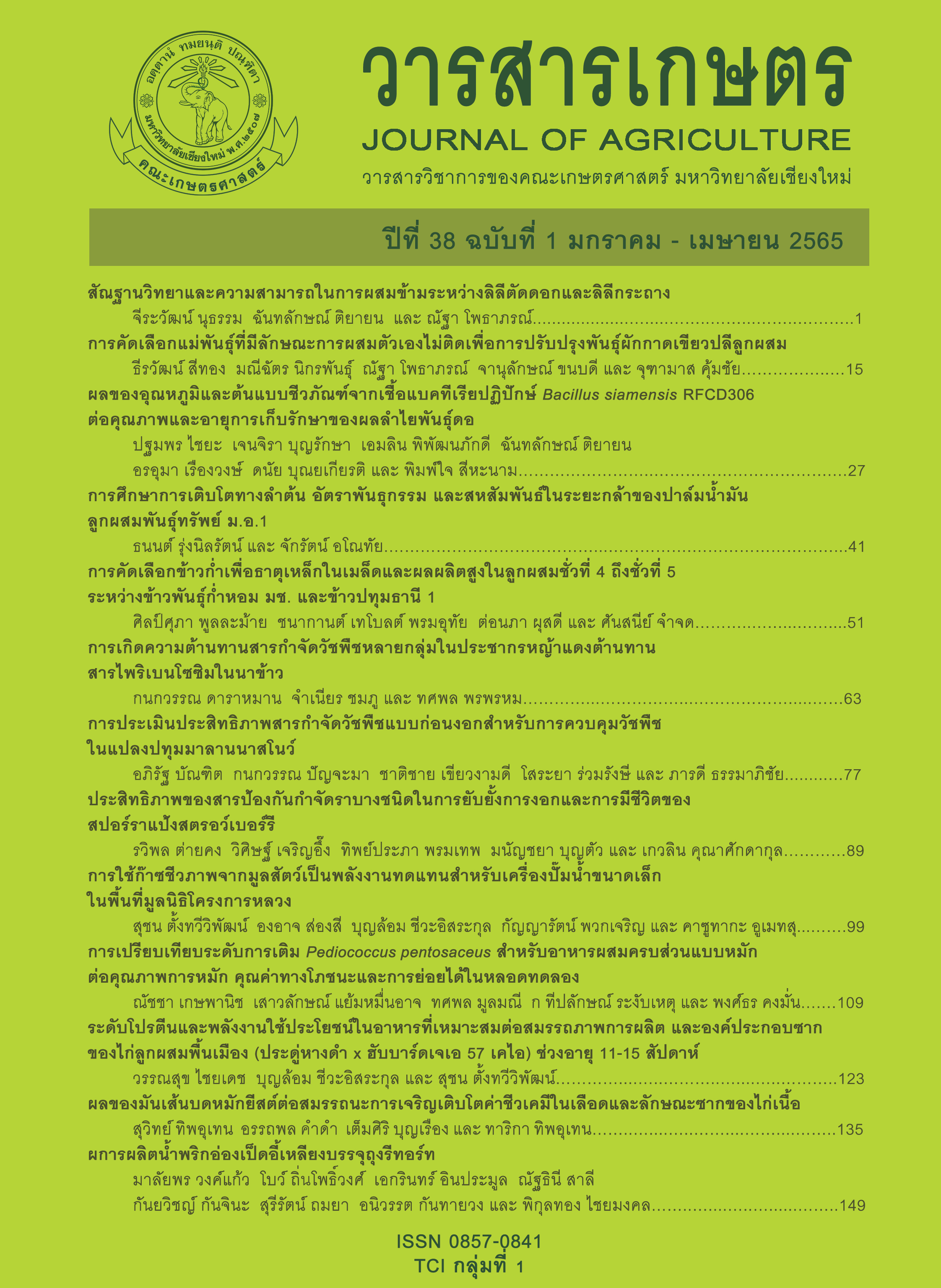การผลิตน้ำพริกอ่องเป็ดอี้เหลียงบรรจุถุงรีทอร์ท
Main Article Content
บทคัดย่อ
วัสดุเหลือทิ้งจากมะเขือเทศพันธุ์โทมัสคุณภาพต่ำและเศษเนื้อเป็ดอี้เหลียงรมควันที่ผ่านการตัดแต่งไม่สมบูรณ์ถูกนำกลับมาใช้ใหม่เป็นผลิตภัณฑ์อาหารล้านนาพร้อมรับประทานที่เรียกว่าน้ำพริกอ่องเป็ดอี้เหลียง งานวิจัยนี้จึงมีวัตถุประสงค์เพื่อหาค่า F0 ของการฆ่าเชื้อน้ำพริกอ่องเป็ดอี้เหลียงบรรจุถุงรีทอร์ทและเพื่อประเมินอายุการเก็บรักษาของผลิตภัณฑ์ในสภาวะเร่ง จากการทดลอง พบว่า อุณหภูมิที่ใช้ในการฆ่าเชื้อน้ำพริกอ่องที่ 115 ºC ในการฆ่าเชื้อเป็นระยะเวลา 5, 10 และ 15 นาที มีค่า F0 เท่ากับ 4 นาที, 8 นาที และ 10 นาที ตามลำดับ สำหรับการประเมินอายุการเก็บรักษาของผลิตภัณฑ์น้ำพริกอ่องเป็ดอี้เหลียงบรรจุถุงรีทอร์ทของทั้ง 3 ระยะเวลา พบว่า อายุการเก็บรักษาผลิตภัณฑ์ที่อุณหภูมิ 30 ºC เก็บรักษาผลิตภัณฑ์ได้เป็นเวลา เท่ากับ 65 วัน โดยค่าความเป็นกรด-ด่าง และคะแนนการยอมรับทางประสาทสัมผัสลดลงหลังจากการเก็บรักษาผลิตภัณฑ์เป็นระยะเวลาสองเดือน แต่ปริมาณเชื้อจุลินทรีย์รวมทั้งหมดยังมีค่าน้อยกว่า 100 โคโลนีต่อกรัม ตลอดระยะเวลาในการเก็บรักษาซึ่งไม่เกินมาตรฐานตามที่ประกาศกระทรวงสาธารณสุขกำหนดไว้ โดยกระบวนการที่ได้จากการศึกษาครั้งนี้ สามารถนำไปใช้เป็นแนวทางในการแปรรูปและวิเคราะห์ผลิตภัณฑ์น้ำพริกชนิดอื่นที่บรรจุถุงรีทอร์ทได้
Article Details

อนุญาตภายใต้เงื่อนไข Creative Commons Attribution-NonCommercial-NoDerivatives 4.0 International License.
เอกสารอ้างอิง
Apirattananusorn, S. and K. Chinabhark. 2013. Development of packages for ready-to-eat chili paste products. KMUTT Research and Development Journal 36(4): 451-464. (in Thai)
ASTM International. 2005. Standard Guide for Sensory Evaluation Methods to Determine the Sensory Shelf Life of Consumer Products. ASTM E2454-05. ASTM International, West Conshohocken, PA.
Chankiatkong, S. 1992. No canned food. DIProm Journal 3: 33-41. (in Thai)
Holdsworth, S.D. and R. Simpson. 2016. Thermal Processing of Packaged Foods. 3rd ed. Springer, Cham. 516 p.
Krusong, W. 1996. Food preservation and processing. pp. 91-113. In: Food Preservation and Processing. Sukhothai Thammathirat Open University, Nonthaburi.
Lapchutiporn, J., P. Tuitemwong, K. Tuitemwong and J. Kunkriangvong. 2008. Accelerated shelf life testing of a "Namkneaw" chilli paste. pp. 301-309. In: Proceedings of 46th Kasetsart University Annual Conference: Science. Kasetsart University, Bangkok. (in Thai)
Maturin. L. and J.T. Peeler. 2001. Chapter 3: Aerobic plate count. In: FDA Bacteriological Analytical Manual. AOAC International, Gaithersburg, MD.
Ministry of Public Health. 2013. Food in a hermetically sealed container. Notification of Ministry of Publish Health (No. 335) B.E. 2556. Ministry of Public Health, Bangkok. (in Thai)
Mizrahi, S. 2004. Accelerating shelf life tests. pp. 317-339. In: P. Steels (ed.). Understanding and Measuring the Shelf-life of Food. Woodhead Publishing Limited, Cambridge.
Parnsakhorn, S., J. Langkapin, P. Pansri and T. Chaiyadam. 2020. Effect of sterilization process on physicochemical properties of lotus leaf wrapped rice in retort pouch product. Journal of Applied Research on Science and Technology 19(1): 1-15. (in Thai)
Phromphichai, R. 1999. Nam Prik Ong. pp. 3258-3259. In: Thailand Cultural Encyclopedia: North. Thailand Culture Encyclopedia Foundation Bangkok. (in Thai)
Ruangchai, S. and S. Tantakasem. 2011. Storage quality of tamarind/roselle chili paste. University of the Thai Chamber of Commerce Journal: Humanities and Social Sciences 31(2): 89-98. (in Thai)
Rungsardthong, V. 2000. Food Processing Technology. King Mongkut's University of Technology North Bangkok, Bangkok: 500 p. (in Thai)
Samdaeng, W., T., Maireng, B. Pimpa and S. Lekjing. 2015. Study on shelf life of common split gill mushroom (Schizophyllum commune) roast curry and chili paste products. Burapha Science Journal 20(2): 33-47. (in Thai)
Sawardsuk, P. 2016. Effect of heating time on physical properties of Thai style stewed mackerel in salty soup packed in retort pouch. Khon Kaen Agriculture Journal 44(2): 257-264. (in Thai)
Sothornvit, R. 2007. Introduction to Food Chemistry and Microbiology. Kasetsart University Press, Bangkok. 231 p. (in Thai)
Tasaudom, U., W. Srapinkaraburi and S. Nipronrum. 2009. The production improvement for shelf-life extension of chili paste products. Naresuan University Journal: Science and Technology 17(2): 136-144. (in Thai)
Tiensanguankul, J. and P. Limpatanachot. 2000. Computer interface technique assisting in F0 determination program for canned food. B.S. Food Engineering Project. Kasetsart University, Bangkok. (in Thai)
Topaiboul, S., P. Aue-anggoon, J. Kongrueng, P. Klomklom, A. Inpramoon and N. Saikaew. 2018. Effect of impaction on bruise of “Xichu (P2)” Persimmons. Journal of Agricultural Research and Extension 35(2): 24-33. (in Thai)
Tung, M.A., I.J. Britt and S. Yada. 2001. Packaging Considerations. pp. 129-145. In: N.A.M. Eskin and D.S. Robinson (eds.). Food Shelf Life Stability: Chemical, Biochemical, and Microbiological Changes. CRC Press, Boca Ration.
Wasantiwong, K., K. Surarakdisai and S. Boonjakoon. 2010. Effect of lethalities of the thermal process (F0) levels on canned Num Phrik Kapi. Journal of Food Health and Bioenvironmental Science 3(1): 75-85. (in Thai)


